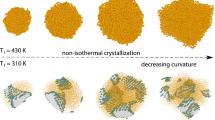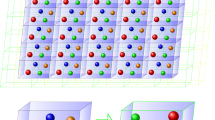Abstract
Although much is known about the metastable liquid branch of hard spheres—from low dimension d up to \({d\rightarrow \infty }\)—its crystal counterpart remains largely unexplored for \(d>3\). In particular, it is unclear whether the crystal phase is thermodynamically stable in high dimensions and thus whether a mean-field theory of crystals can ever be exact. In order to determine the stability range of hard sphere crystals, their equation of state is here estimated from numerical simulations, and fluid-crystal coexistence conditions are determined using a generalized Frenkel–Ladd scheme to compute absolute crystal free energies. The results show that the crystal phase is stable at least up to \(d={10}\), and the dimensional trends suggest that crystal stability likely persists well beyond that point.






Similar content being viewed by others
Data availability
Data relevant to this work have been archived and can be accessed at the Duke Digital Repository [57].
References
G. Battimelli, G. Ciccotti, P. Greco, Computer Meets Theoretical Physics: The New Frontier of Molecular Simulation, The Frontiers Collection (Springer International Publishing, NY, 2020). https://doi.org/10.1007/978-3-030-39399-1
P. Charbonneau, J. Kurchan, G. Parisi, P. Urbani, F. Zamponi, Annu. Rev. Condens. Matter Phys. 8, 265 (2017). https://doi.org/10.1146/annurev-conmatphys-031016-025334
G. Parisi, F. Zamponi, Rev. Mod. Phys. 82, 789 (2010). https://doi.org/10.1103/RevModPhys.82.789
G. Parisi, P. Urbani, F. Zamponi, Theory of Simple Glasses: Exact Solutions in Infinite Dimensions (Cambridge University Press, Cambridge, 2020)
B. Charbonneau, P. Charbonneau, G. Tarjus, Phys. Rev. Lett. 108, 035701 (2012). https://doi.org/10.1103/PhysRevLett.108.035701
B. Charbonneau, P. Charbonneau, G. Tarjus, J. Chem. Phys. 138, 12A515 (2013). https://doi.org/10.1063/1.4770498
P. Charbonneau, Y. Jin, G. Parisi, F. Zamponi, Proc. Natl. Acad. Sci. U.S.A. 111, 15025 (2014). https://doi.org/10.1073/pnas.1417182111
M. Mangeat, F. Zamponi, Phys. Rev. E 93, 012609 (2016). https://doi.org/10.1103/PhysRevE.93.012609
J.A. van Meel, D. Frenkel, P. Charbonneau, Phys. Rev. E 79, 030201 (2009a). https://doi.org/10.1103/PhysRevE.79.030201
J.A. van Meel, B. Charbonneau, A. Fortini, P. Charbonneau, Phys. Rev. E 80, 061110 (2009). https://doi.org/10.1103/PhysRevE.80.061110
M. Skoge, A. Donev, F.H. Stillinger, S. Torquato, Phys. Rev. E 74, 041127 (2006). https://doi.org/10.1103/PhysRevE.74.041127
P. Charbonneau, A. Ikeda, J.A. van Meel, K. Miyazaki, Phys. Rev. E 81, 040501 (2010). https://doi.org/10.1103/PhysRevE.81.040501
J. H. Conway, N. J. A. Sloane, Sphere Packings, Lattices and Groups, 3rd ed., Grundlehren der mathematischen Wissenschaften (Springer-Verlag, New York, 1999). https://www.springer.com/gp/book/9781475722499
N. Clisby, B.M. McCoy, J. Stat. Phys. 122, 15 (2006). https://doi.org/10.1007/s10955-005-8080-0
M. Bishop, P.A. Whitlock, J. Chem. Phys. 123, 014507 (2005). https://doi.org/10.1063/1.1874793
L. Lue, M. Bishop, Phys. Rev. E 74, 021201 (2006). https://doi.org/10.1103/PhysRevE.74.021201
C. Zhang, B.M. Pettitt, Mol. Phys. 112, 1427 (2014). https://doi.org/10.1080/00268976.2014.904945
D. Frenkel, A.J.C. Ladd, J. Chem. Phys. 81, 3188 (1984). https://doi.org/10.1063/1.448024
D. Frenkel, B. Smit, Understanding Molecular Simulation: From Algorithms to Applications, 2nd edn. (Academic Press, NY, 2001)
V. Khanna, J. Anwar, D. Frenkel, M.F. Doherty, B. Peters, J. Chem. Phys. 154, 164509 (2021). https://doi.org/10.1063/5.0044833
M. Best, IEEE Trans. Inf. Theory 26, 738 (1980). https://doi.org/10.1109/TIT.1980.1056269
We do not here consider the special case \(d=2\), for which the liquid to solid transition proceeds through a hexatic phase, with a weakly first-order liquid-hexatic transition and a continuous hexatic-solid transition [38,58]. Our methodology is indeed not adapted to this situation
The term Bravais lattice is here used to denote what is known in the mathematical literature simply as a lattice. Within physics and chemistry communities, \(P_{10c}\) could be said to be a lattice with a \(40\)-particle basis, but we instead describe it as a non-Bravais-lattice packing to minimize possible confusion with the mathematical terminology
H.S.M. Coxeter, J.A. Todd, Can. J. Math. 5, 384 (1953). https://doi.org/10.4153/CJM-1953-043-4
J. Conway, N. Sloane, IEEE Trans. Inf. Theory 28, 227 (1982). https://doi.org/10.1109/TIT.1982.1056484
P. Charbonneau, Y. Hu, J. Kundu, P. Morse, In preparation (2021)
P. Charbonneau, P. Morse, W. Perkins, F. Zamponi, In preparation (2021)
S. Pieprzyk, M.N. Bannerman, A.C. Brańka, M. Chudak, D.M. Heyes, Phys. Chem. Chem. Phys. 21, 6886 (2019). https://doi.org/10.1039/C9CP00903E
K.R. Hall, J. Chem. Phys. 57, 2252 (1972). https://doi.org/10.1063/1.1678576
R.J. Speedy, J. Phys. Condens. Matter 10, 4387 (1998). https://doi.org/10.1088/0953-8984/10/20/006
P. Tarazona, Phys. Rev. Lett. 84, 694 (2000). https://doi.org/10.1103/PhysRevLett.84.694
J.M. Polson, E. Trizac, S. Pronk, D. Frenkel, J. Chem. Phys. 112, 5339 (2000). https://doi.org/10.1063/1.481102
B. Groh, B. Mulder, J. Chem. Phys. 114, 3653 (2001). https://doi.org/10.1063/1.1342816
G.M. Torrie, J.P. Valleau, J. Comput. Phys. 23, 187 (1977). https://doi.org/10.1016/0021-9991(77)90121-8
P. Charbonneau, A. Ikeda, G. Parisi, F. Zamponi, Phys. Rev. Lett. 107, 185702 (2011). https://doi.org/10.1103/PhysRevLett.107.185702
N.B. Wilding, A.D. Bruce, Phys. Rev. Lett. 85, 5138 (2000). https://doi.org/10.1103/PhysRevLett.85.5138
N. B. Wilding, Comput. Phys. Commun. 146, 99 (2002). https://doi.org/10.1016/S0010-4655(02)00440-X
M. Engel, J.A. Anderson, S.C. Glotzer, M. Isobe, E.P. Bernard, W. Krauth, Phys. Rev. E 87, 042134 (2013). https://doi.org/10.1103/PhysRevE.87.042134
J. Ruiz-Franco, E. Zaccarelli, H.J. Schöpe, W. van Megen, J. Chem. Phys. 151, 104501 (2019). https://doi.org/10.1063/1.5114720
X.-Z. Wang, J. Chem. Phys. 122, 044515 (2005). https://doi.org/10.1063/1.1840444
C. A. Rogers, Proc. London Math. Soc. s3-8, 609 (1958) https://doi.org/10.1112/plms/s3-8.4.609
H. Cohn, N. Elkies, Ann. Math. 157, 689 (2003). https://doi.org/10.4007/annals.2003.157.689
M. S. Viazovska, Ann. Math 185, 991 (2017). https://www.jstor.org/stable/26395747
H. Cohn, Not. Am. Math. Soc. 64, 102 (2017). https://doi.org/10.1090/noti1474
C.D. Estrada, M. Robles, J. Chem. Phys. 134, 044115 (2011). https://doi.org/10.1063/1.3530780
W.G. Hoover, F.H. Ree, J. Chem. Phys. 49, 3609 (1968). https://doi.org/10.1063/1.1670641
J.P.J. Michels, N.J. Trappeniers, Phys. Lett. A 104, 425 (1984). https://doi.org/10.1016/0375-9601(84)90749-7
R.J. Speedy, J. Phys.: Condens. Matter 9, 8591 (1997). https://doi.org/10.1088/0953-8984/9/41/006
B.J. Alder, T.E. Wainwright, J. Chem. Phys. 27, 1208 (1957). https://doi.org/10.1063/1.1743957
G. Bryant, S.R. Williams, L. Qian, I.K. Snook, E. Perez, F. Pincet, Phys. Rev. E 66, 060501 (2002). https://doi.org/10.1103/PhysRevE.66.060501
C. Vega, E.G. Noya, J. Chem. Phys. 127, 154113 (2007). https://doi.org/10.1063/1.2790426
D. Richard, T. Speck, J. Chem. Phys. 148, 224102 (2018a). https://doi.org/10.1063/1.5025394
D. Richard, T. Speck, J. Chem. Phys. 148, 124110 (2018b). https://doi.org/10.1063/1.5016277
M. Bültmann, T. Schilling, Phys. Rev. E 102, 042123 (2020). https://doi.org/10.1103/PhysRevE.102.042123
P.F. Damasceno, M. Engel, S.C. Glotzer, Science 337, 453 (2012). https://doi.org/10.1126/science.1220869
R.D. Batten, F.H. Stillinger, S. Torquato, Phys. Rev. E 81, 061105 (2010). https://doi.org/10.1103/PhysRevE.81.061105
“Duke digital repository,” https://doi.org/10.7924/r4jh3mw3w
E.P. Bernard, W. Krauth, Phys. Rev. Lett. 107, 155704 (2011). https://doi.org/10.1103/PhysRevLett.107.155704
Acknowledgements
We thank Yi Hu, Irem Altan, and Francesco Zamponi for fruitful discussions. Additionally, we thank Henry Cohn for suggesting to expand this work to \(d=10\). This work was supported by grants from the Simons Foundation (#454937, Patrick Charbonneau) and from the National Science Foundation under Grant DMR-2026271 (Robert Hoy). The computations were carried out on the Duke Compute Cluster (DCC), for which the authors thank Tom Milledge’s assistance.
Author information
Authors and Affiliations
Contributions
PC, RSH, and PKM designed the research and wrote the manuscript; CMG and PKM performed simulations; PC, CMG, RSH, and PKM analyzed data. Author list is alphabetical.
Corresponding author
Free energy of a single particle in the periodic reference crystal field
Free energy of a single particle in the periodic reference crystal field
A minimal model of the periodic potential crystal reference calculation is a single particle evolving in the field given by Eq. (18) (see Fig. 5). Because the problem can then be solved analytically, it provides a robust benchmark for our numerical implementation and its optimization.
Integrand of Eq. (19) for a single particle in the periodic \(d=3\) reference crystal from direct integration (black line), direct simulation of the periodic potential (red points), and simulation of the umbrella potential of Eq. (21) (blue points). The different results are indistinguishable below \(\lambda \approx 10\), but for \(\lambda \gtrsim 10\) results from the umbrella potential deviate from the correct solution due to poor sampling of the bottom of the potential well, wherein the particle is then largely confined
The integrand of Eq. (19) can then be written explicitly as
and thus the system free energy is \(\beta F = -\beta \int _0^\lambda \langle U({\mathbf {r}},\lambda ')\rangle _{\lambda '}\). Although the integrand lacks a closed form expression for \(d>1\), it can be evaluated numerically with very high accuracy for any \(\lambda \) and d. The results for \(d=3\) serve as an analytical reference in Fig. 7. Equivalently, the free energy can be computed directly from the standard statistical mechanics expression, \(\beta F = -\ln Z\), for the partition function Z, and hence
This expression also does not have a closed form, but can be calculated numerically with high accuracy.
These quantities can be used to benchmark the standard Monte Carlo sampling of the periodic potential as well as by the umbrella sampling scheme described in Sect. 4.3. For \(\lambda \gg 1\) standard Monte Carlo sampling leaves the particle trapped at the bottom of one of the wells, but as \(\lambda \) decreases the particle regularly explores barriers and crosses over into neighboring wells. Given sufficient sampling, the intermediate \(\lambda \) regime is recovered (see Fig. 7), and thus the various features of the direct integration are recapitulated.
This outcome contrasts with Monte Carlo simulations that use the umbrella sampling approach of Eq. (22). In this case, the particle samples all points in the box with equal probability, even though the actual contribution to the partition function of each point is proportional to its Boltzmann weight, \(\exp [-\lambda \beta U]\). In the single particle case, both simple Monte Carlo and umbrella sampling work well for \(\lambda \lesssim 10\). However, for \(N>1\) and \(\lambda \sim 1/N\) standard Monte Carlo sampling fails because it then becomes rare for simulations to produce particles which are near the top of energy barriers, whose contributions remain important for accurately calculating the free energy.
For \(\lambda \gg 1\), the Boltzmann weight \(\exp [-\lambda \beta U]\) concentrates, and the only significant contributions to Z come from a small collection of (degenerate) points in phase space, i.e., the bottom of each well. Both the numerator and the denominator of Eq. (21) diverge in this limit, making the evaluation numerically unstable. Physically, this instability corresponds to \(\langle U \rangle \) being vastly undersampled compared with other \(\lambda \) regimes, thus leading to marked deviation from the exact result (Fig. 7).
This analysis motivates the high \(\lambda \) cutoff used in the umbrella sampling for \(N>1\). Because the Boltzmann weight \(\exp [-\lambda \beta \sum _i U_i]\) acts on the total energy, the same cutoff of \(\lambda =1\) can be used. However, as N grows, it is important to sum these contributions carefully, because \(\theta \) then also grows.
Rights and permissions
About this article
Cite this article
Charbonneau, P., Gish, C.M., Hoy, R.S. et al. Thermodynamic stability of hard sphere crystals in dimensions 3 through 10. Eur. Phys. J. E 44, 101 (2021). https://doi.org/10.1140/epje/s10189-021-00104-y
Received:
Accepted:
Published:
DOI: https://doi.org/10.1140/epje/s10189-021-00104-y





